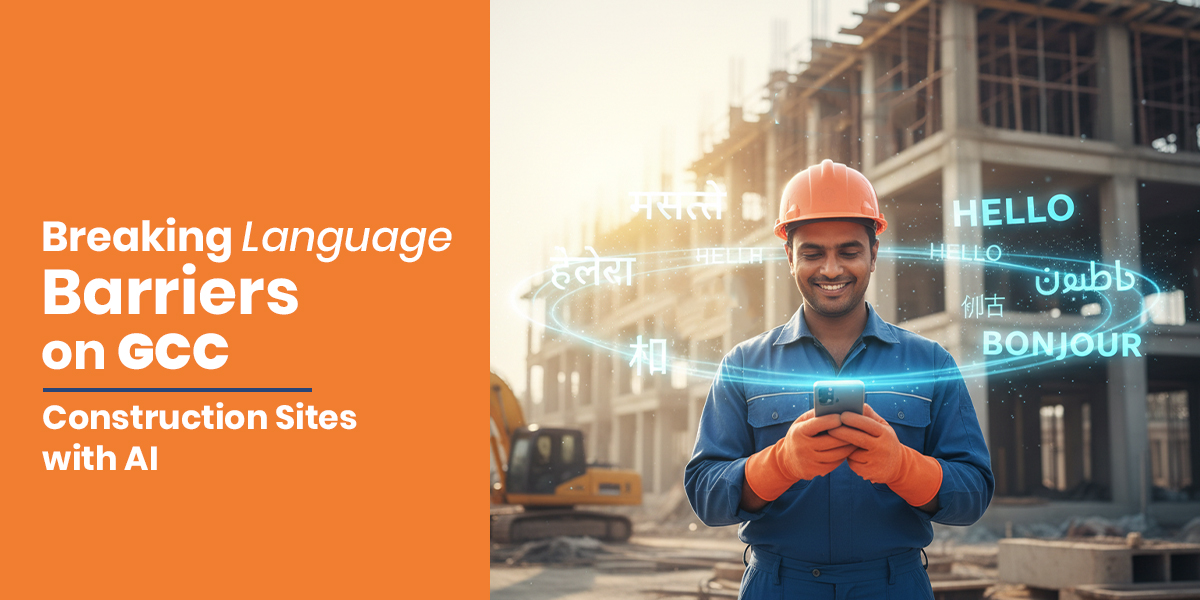Breaking Language Barriers on GCC Construction Sites with AI
On a typical construction site in Dubai, you might hear conversations in Arabic, Hindi, Urdu, Bengali, Tagalog, English, Spanish, and more. Sometimes, all within the same project meeting.
This diversity is a strength. But when safety and clarity depend on quick understanding, language differences can slow things down.
The good news? The region has always managed multilingual teams. Now, AI is making communication faster, clearer, and more inclusive.
Studies consistently show that language gaps harm safety. In some cases, such misunderstandings lead to injuries and even fatalities. [1][2]
Even if hazards are flagged, delays caused by translation bottlenecks can mean slower responses, lost trust, and real risks such as:
Safety Risks – A misunderstood instruction about scaffolding or heavy machinery can directly cause injuries. The UK’s Institution of Occupational Safety and Health (IOSH) noted that workers with limited language skills are disproportionately represented in workplace accidents.
Delayed Incident Reporting – Workers hesitate to report hazards or near-misses if they’re unsure how to express them. This delay reduces the chance of preventing escalation.
Operational Inefficiencies – Supervisors spend valuable hours translating instructions or explaining procedures multiple times. This slows project timelines and diverts focus from leadership to basic communication.
Trust & Inclusion Gaps – When workers feel their voices are not understood, morale drops. They may disengage from safety conversations, which weakens the culture of care.
Using AI to just translate text inputs is too primitive. AI can be used to ensure seamless communication in real-world site conditions, regardless of the mode of operation.
Real-time Multilingual Chat
Messages in WhatsApp, Teams, or other apps are translated instantly across languages.
Voice Note Understanding
A worker leaves a voice note in, say, Tagalog. AI understands it, translates it, and delivers it swiftly.
Image-Based Assistance
If a photo of a hazard is shared, AI can explain or ask follow-up questions in that worker’s language.
Two-Way Conversation
Workers can ask, AI responds, and clarity occurs in real-time in any language, via any medium (text, voice, image).
Navatech’s contribution to breaking the communication barrier
At Navatech, we’ve built solutions that fit directly into daily site operations. The goal is to make safety communication as natural as sending a text or speaking to a friend.
nAI Hub
Workers use familiar apps like WhatsApp or WeChat to access safety information that is instantly translated into their language. It goes beyond text: workers can ask questions, share images, or speak voice notes. The system replies in their language, reducing training fatigue and boosting real engagement.
Instead of skipping through a 400-page safety manual in English, a worker asks: “Is it safe to use this ladder today?” The AI replies in their language with site-specific guidance.
nAI Flow
Construction teams often rely on chat groups for day-to-day coordination. nAI Flow integrates directly into those chats. If an incident is mentioned, AI automatically assigns the task to the right safety officer and updates progress, all while translating across languages.
A worker types in Urdu, “There’s a water leak near the electrical box.” The AI translates it into English for the safety manager, creates a task, and ensures the issue is tracked to resolution.
The story of multilingual construction in the GCC is ultimately a story of human cooperation enhanced by intelligent technology. Workers from dozens of countries collaborate daily to build some of the world’s most ambitious projects.
Language differences should not prevent this cooperation. AI doesn’t replace the human connections that make construction work; it removes barriers that prevent those connections from forming.
When a native Thai-speaking electrician can explain a wiring concern to a native Arabic-speaking supervisor, who can in turn relay technical requirements to a native Hindi-speaking project manager, everyone benefits from clearer communication and better outcomes.
The progress already made in GCC multilingual construction demonstrates what’s possible when diversity is treated as a strength rather than a challenge.
Projects succeed when teams understand each other. Safety improves when workers can communicate concerns effectively. Quality increases when instructions are comprehended correctly.
The future of construction communication is multilingual, multicultural, and more collaborative than ever. Technology will continue improving, but the foundation remains human. People who want to understand each other and work together toward shared goals.
It’s all about enabling perfect collaboration. When language stops being a barrier and starts being a bridge, construction teams can focus on what they do best i.e. building remarkable projects that enhance communities and economies worldwide.
The path is simple, embrace the linguistic diversity that makes your teams stronger. Use technology that respects and enhances that diversity rather than trying to eliminate it. Build projects that speak everyone’s language. The language of safety, quality, and shared success.
